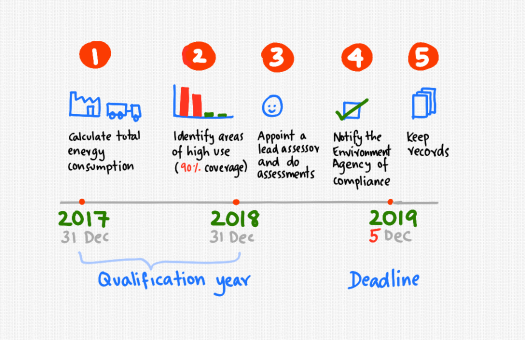
ESOS is the Energy Savings Opportunity Scheme run by the Environment Agency to comply with the EU's Energy Efficiency Directive.
It applies to businesses, charities and non-public sector organisations that are large enough to qualify.
Organisations qualify if, on the 31st of December 2018 (or the financial year just ended), they meet the ESOS definition of a large organisation - i.e, they employ more than 250 people or have a turnover of more than €50 million or a balance sheet of more €43 million during the year.
In a group company, if one part qualifies, then the whole qualifies and the highest UK parent company needs to be responsible for compliance - unless the responsibility is transferred to another group company.
The UK parts of overseas companies need to take part if any part of their group activities qualify in the UK.
So, the quick way to ESOS compliance is:
1. Work out your total energy consumption
This is simple if there are already systems in place that collect and process invoice data. If not, there is some data collection to carry out.
Most organisations will have quite good electricity and gas information. Other fuels and transport records are sometimes harder to find.
2. Identify areas of significant energy consumption
You need to identify at least 90% of usage and then figure out what existing assessments already cover these such as ISO 50001, DECs or GDAs.
The rest need to be covered with ESOS compliant audits.
The scope of the audits are decided by the lead auditor but the Association of Energy Engineers (AEE), for example, suggests than an ASHRAE Level 2 Audit which includes some measurement is appropriate.
Other schemes may have different requirements but they all will include a review of data, analysis of consumption and efficiency, identification of opportunities, site visits and a completed evidence pack that sets out the organisation's approach to compliance.
3. Appoint a lead assessor
A lead assessor needs to do and oversee or review energy audits and overall assessment.
They (or their team) can either do the work, or work with you to review existing work - although they will be responsible for signing it off as compliant.
All lead assessors will be listed on their professional body registers.
4. Notify the Environment Agency
The Environment Agency must be notified using an online form by the 5th of December 2019.
5. Keep records
You need to keep an evidence pack of how you have carried out ESOS.
Then what?
Many ESOS reports the last time round were done and then left on a shelf to gather dust.
A significant issue is that many organisations are already quite energy efficient, especially when it comes to the large process tasks and pieces of kit that use the majority of industrial energy.
These pieces of kit can't be quickly replaced and will have a upgrade and replacement cycle of their own.
As a result, a good ESOS assessment isn't just an external audit at a point in time but a move towards an ongoing system of energy management and continuous improvement in energy efficiency.
Eventually, the activities being done could be formalised in an energy management system such as ISO50001.
Ideally - the output from the ESOS assessment will do two things:
- Come up with an action plan: Identify and rank projects that are doable - technically feasible - and have a payback that works for the company.
- Create a tender: Package up the rest of the projects for an Energy Services Company - so that the organisation can benefit from the savings while someone else takes on responsibility for implementation and financing.
Although the notification deadline is still some time away many of the activities can be carried out over the entire four-year period between deadlines, for example, the audits can be carried out on different parts of the portfolio during different years.
So… the place to start is with the data - and please do get in touch if you have any questions.
Read more posts at Karthik-Suresh.com or connect with me on LinkedIn.